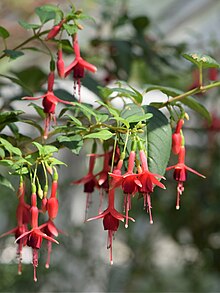Fuchsia coccinea
| Fuchsia coccinea | |
|---|---|

| |
| Scientific classification | |
| Kingdom: | Plantae |
| Clade: | Tracheophytes |
| Clade: | Angiosperms |
| Clade: | Eudicots |
| Clade: | Rosids |
| Order: | Myrtales |
| Family: | Onagraceae |
| Genus: | Fuchsia |
| Species: | F. coccinea
|
| Binomial name | |
| Fuchsia coccinea Aiton 1789
| |
| Synonyms | |
| |
Fuchsia coccinea is a species of Fuchsia found in Brazil.[1]
Description[edit]
Fuchsia coccinea are tall shrubs, reaching 0.5-1.5 m in height, sometimes climbing up to 7 m, with puberulent to densely pilose young growth and exfoliating bark on older stems. The leaves are mostly ternate, occasionally opposite or in 4s, and are membranous or rarely subcoriaceous, narrowly ovate to ovate, 15-55 mm long and 7-25 mm wide. They have acute to subacuminate apexes, subcordate or sometimes rounded bases, and are generally dull light green, paler below, and sometimes strongly purple-flushed. The leaves are subglabrous to puberulent on both sides, but generally densely pilose along the basal Y3 of the midvein below, with serrulate or occasionally subentire margins and 4-6 secondary veins per side. The petioles are short and stout, about 1 mm thick and 1-3 mm long, usually densely pilose or hirsute, occasionally longer on basal leaves. The stipules are narrowly lanceolate, 0.8-1.4 mm long, and deciduous. The flowers are solitary in the upper leaf axils, with slender pubescent pedicels 18-42(-50) mm long, diverging or arching from the stems and pendent only in the distal third. The ovary is oblong-ellipsoid, 5-9 mm long and 2.5-3 mm thick, with a fusiform floral tube 5-10 mm long, 2.5-3 mm wide at the base, 3.5-4.5 mm wide in the middle, and 3-4 mm wide at the top. The tube and sepals are red to dark pink, with oblong-lanceolate sepals 15-24 mm long, lightly pubescent, connate at the base for 4-7 mm, and free lobes 3.5-6 mm wide, acute at the apex, and spreading at anthesis. The petals are violet, obovate, 7-10 mm long and 6-8(-9) mm wide. The filaments are red-purple, 18-38 mm and 13-30 mm long, and the anthers are purplish, 2-2.5 mm long and about 1.5 mm wide. The style is puberulent and red, with a clavate stigma 1.5-2 mm long, exserted about 15 mm beyond the anthers. The mature berry is ellipsoid, 14-17 mm long and about 12 mm thick, and purple. The seeds are oblong-triangular, 1.4-1.9 mm long and 0.8-1.2 mm wide.[2]
References[edit]
- ^ "Plants of the World Online". Plants of the World Online. Retrieved 2024-04-21.
- ^ "Onagraceae". Species Page/ Botany, National Museum of Natural History, Smithsonian Institution. Retrieved 2024-04-24.
External links[edit]
 Media related to Fuchsia coccinea at Wikimedia Commons
Media related to Fuchsia coccinea at Wikimedia Commons Data related to Fuchsia coccinea at Wikispecies
Data related to Fuchsia coccinea at Wikispecies
